Chemistry and Chemists № 1 2024
Journal of Chemists-Enthusiasts
| Content | Chemistry experiments - video | Physics experiments - video | Home Page - Chemistry and Chemists |
|
Chemistry and Chemists № 1 2024 Journal of Chemists-Enthusiasts |
Reaction of copper metal with acetic acid pt.4 V.M. Viter |
|
Having noticed a mistake in the text, allocate it and press Ctrl-Enter
Copper acetate, copper sulfate and zinc metal - pt.4
The previous part of the article described the reactions of iron with the solutions of copper sulfate and copper acetate. From a chemical point of view, the experiment worked, but from an aesthetic point of view, I was unsatisfied. Therefore, I decided to experiment with the same solutions again, although in addition to copper, they now contained divalent iron: Ацетат меди, сульфат меди и металлический цинк - ч.4 Cu2+ + Fe = Fe2+ + Cu Another available metal that easily could displace copper from its salts was zinc. I added a few zinc granules to the glass containing the copper sulfate solution. The surface of the metal immediately began to become covered with a black coating of copper. While watching the experiment video, I noticed that the copper layer appeared black in some places and red in others (similar to the previous experiment). Copper was released as a voluminous sponge that was easily separated from the zinc surface by stirring. Cu2+ + Zn = Zn2+ + Cu During stirring, it became noticeable that gas bubbles had formed. Likely, a parallel reaction occurred - the zinc slowly reacted with hydrogen ions, forming hydrogen gas. The copper sulfate solution is acidic (pH<7) due to partial hydrolysis. Metallic copper forms a galvanic couple with zinc, which accelerates the reaction of zinc with hydrogen ions. 2H+ + Zn = Zn2+ + H2 By the way, Devarda's alloy, which consists of zinc, aluminium and copper, reacts with water at room temperature, releasing hydrogen. During this reaction, the formation of hydrogen bubbles can be easily observed visually. In the case of zinc granules and copper sulfate solution, I noticed the formation of bubbles during stirring only. These bubbles accumulated in the pores of spongy copper and were released through mechanical action. Significantly, the release of metallic copper on the surface of zinc occurred much faster than on the surface of iron. When the goal is to precipitate copper from industrial solutions to recover it, iron is preferable to zinc (since zinc is more expensive than iron and is more environmentally toxic). However, zinc is better for displacement reactions during chemical demonstrations in front of an audience, for example, the displacement of copper metal from copper salt solutions. Then, I took the solution of copper acetate and added a few zinc granules to it. A copper sponge began to form on the surface of the zinc; in some places, it was black, in others red. The rate of formation of metallic copper was noticeably lower than that observed in the reaction between copper sulfate and zinc. But, in a glass with copper acetate, an active release of hydrogen bubbles was observed. As noted above, the copper acetate solution contained an excess of acetic acid. Acetic acid reacted with zinc, and the copper metal accelerated this process. Over time, the rate of hydrogen evolution did not weaken, but the intensity of the colour of the solution decreased. Coloured copper cations precipitated to form metallic copper; as a result, they were replaced in the solution by colourless zinc cations. Meanwhile, the copper sulfate solution became cloudy and began to take on a green tint in the other glass. At the bottom of the glass was the red and black copper sponge. I left the solutions overnight. Until the morning, the solution in the glass with copper acetate became discoloured (all the copper was precipitated as metallic copper), and the hydrogen evolution continued. In the glass with copper sulfate, the solution became greenish-yellow and cloudy. At the bottom were the metallic copper precipitate and a brown precipitate similar to iron (III) hydroxide, Fe(OH)3. After 48 hours, gas was still released (!) in the beaker that initially contained the copper acetate solution. The solution remained transparent and colourless. At the bottom was the grey sponge of metallic copper. In the beaker that initially contained copper sulfate, the solution turned brown and cloudy. Its appearance resembled an iron (III) hydroxide suspension (rust). There was the brown precipitate at the bottom. The formation of iron (III) hydroxide can be simply explained. During the reaction of copper sulfate and iron metal, iron (II) sulfate was formed, which remained in the solution. There was no excess acid in the beaker with copper sulfate. Moreover, part of the hydrogen ions formed during the hydrolysis of copper sulfate reacted with zinc. In a neutral, and even more so, alkaline solution, iron (II) salts are oxidized by oxygen in the air to form iron (III) hydroxide (or basic salts of trivalent iron): 4Fe2+ + O2 + 10H2O = 4Fe(OH)3 + 8H+ In the glass with copper acetate, there was an excess of acetic acid (making the solution acidic, pH < 7). Additionally, active hydrogen evolution occurred, partly isolating the solution from atmospheric oxygen. Consequently, the formation of iron (III) hydroxide was not observed. Moreover, under these conditions, iron (II), present in the solution, could be reduced to metallic iron. The last statement is not a mere theory. For example, the author has repeatedly observed that magnesium metal reduces a solution of iron(II) sulfate or iron(III) chloride to metallic iron [1]. Therefore, we have two glasses with liquid and precipitate. In one, the liquid is transparent and colourless; in the other, there is a suspension of iron (III) hydroxide above the precipitate. To demonstrate the Tyndall effect, I took a green laser pointer. In the glass containing the suspension, the laser beam was well visible, forming a bright green line with a side glow because the iron hydroxide particles scattered the light. Light scattering was also observed in the glass containing the colourless solution due to hydrogen bubbles, but it was much weaker. __________________________________________________ 1 See the articles The precipitation of metallic iron from a solution of iron (II) sulfate / Получение железа из водного раствора сульфата железа (II) [link]; The reaction of magnesium with iron (III) chloride in an aqueous solution / Реакция магния с хлоридом железа (III) в водном растворе [link]. |

Copper acetate, copper sulfate and zinc metal |

|

|
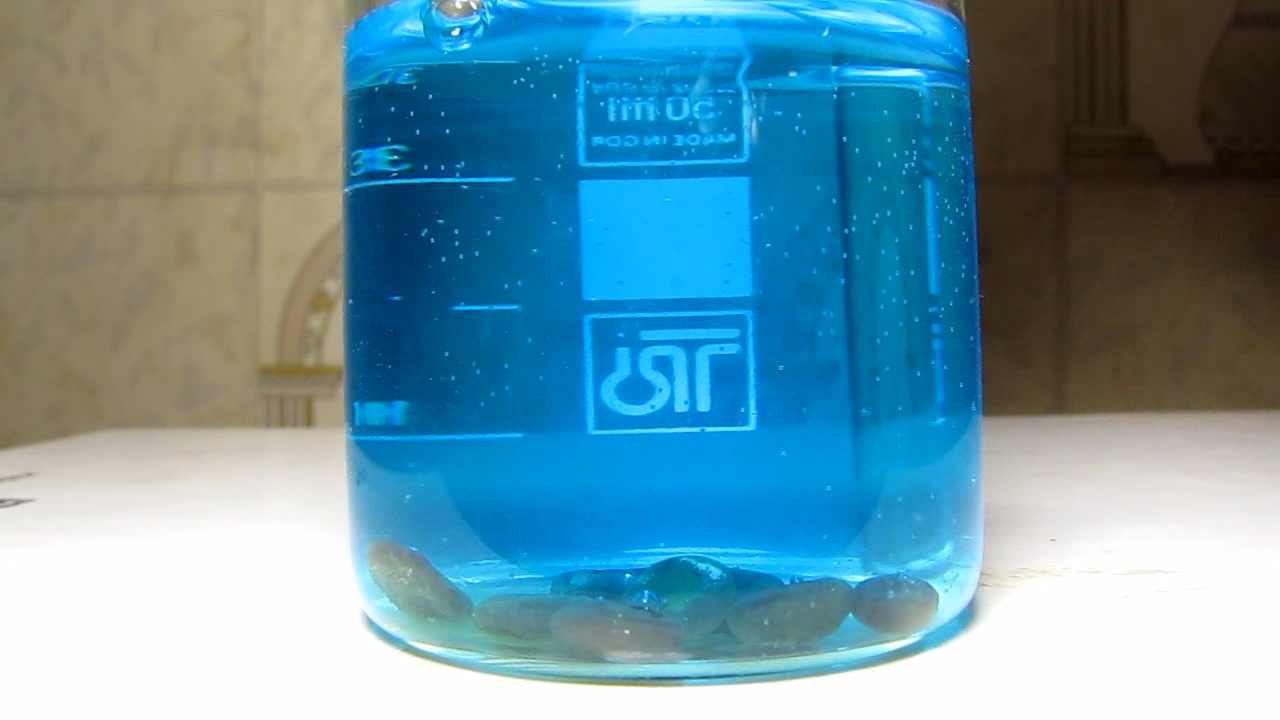
|
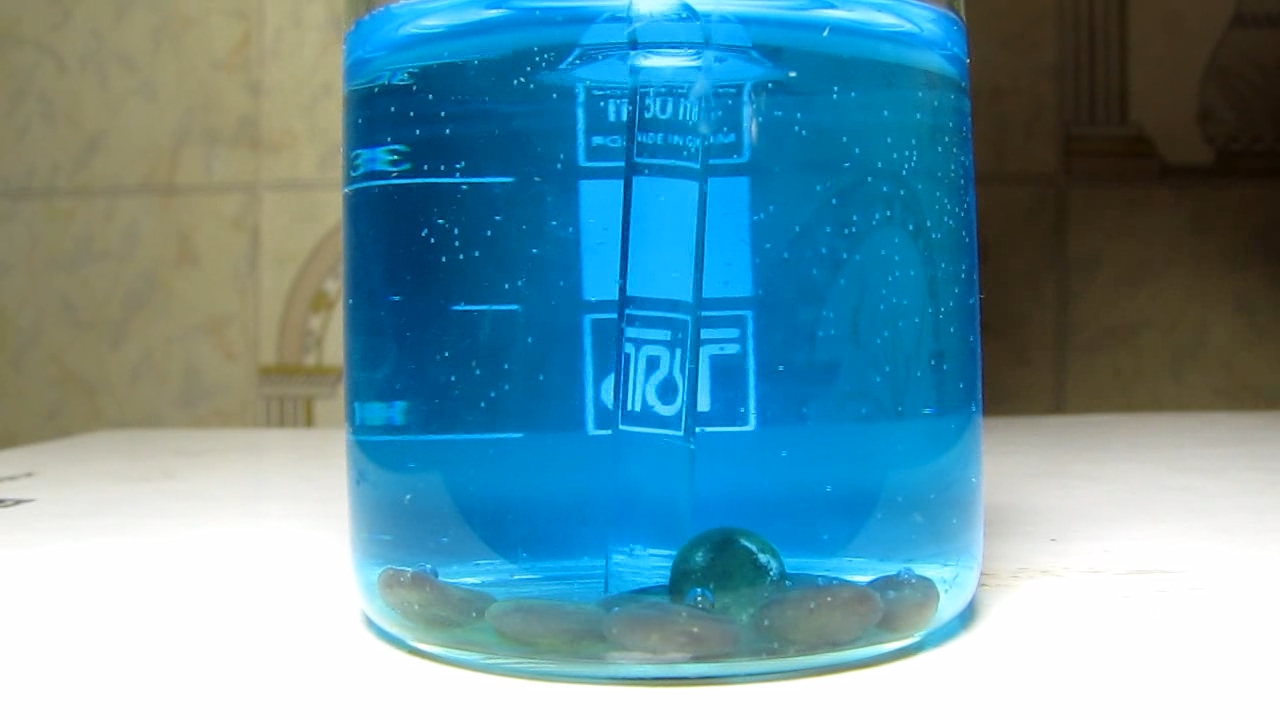
|

|
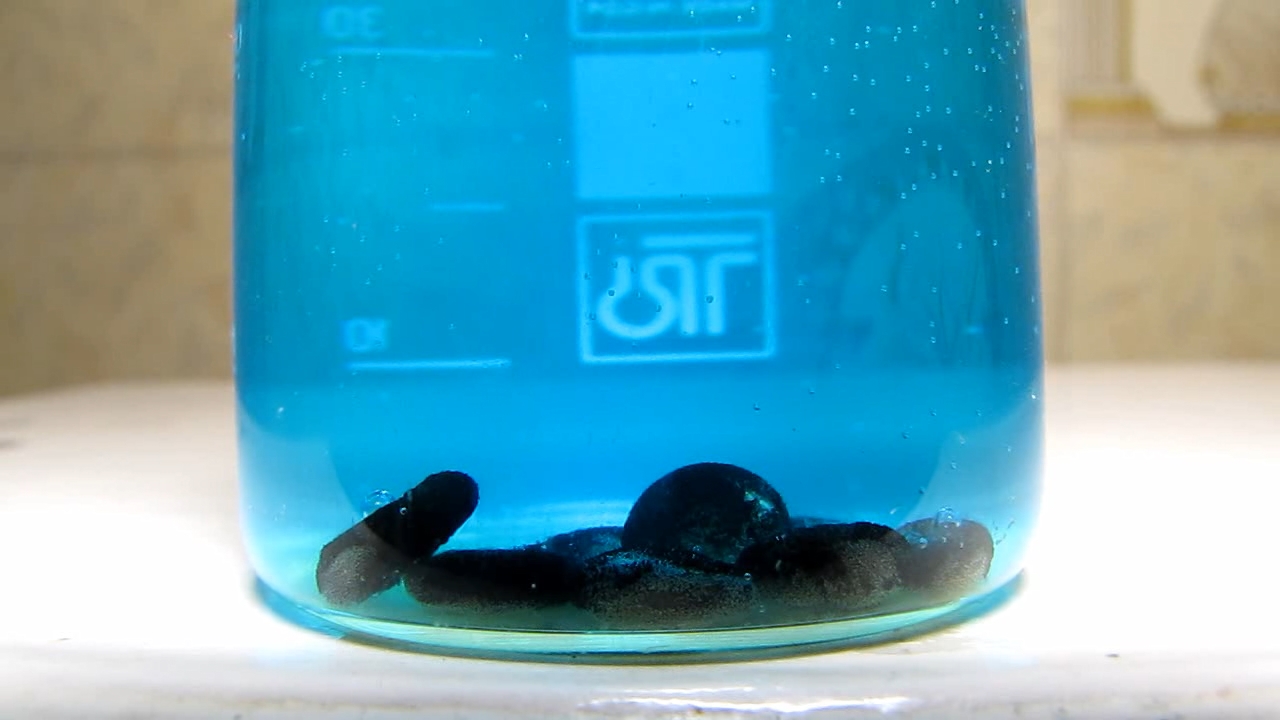
|
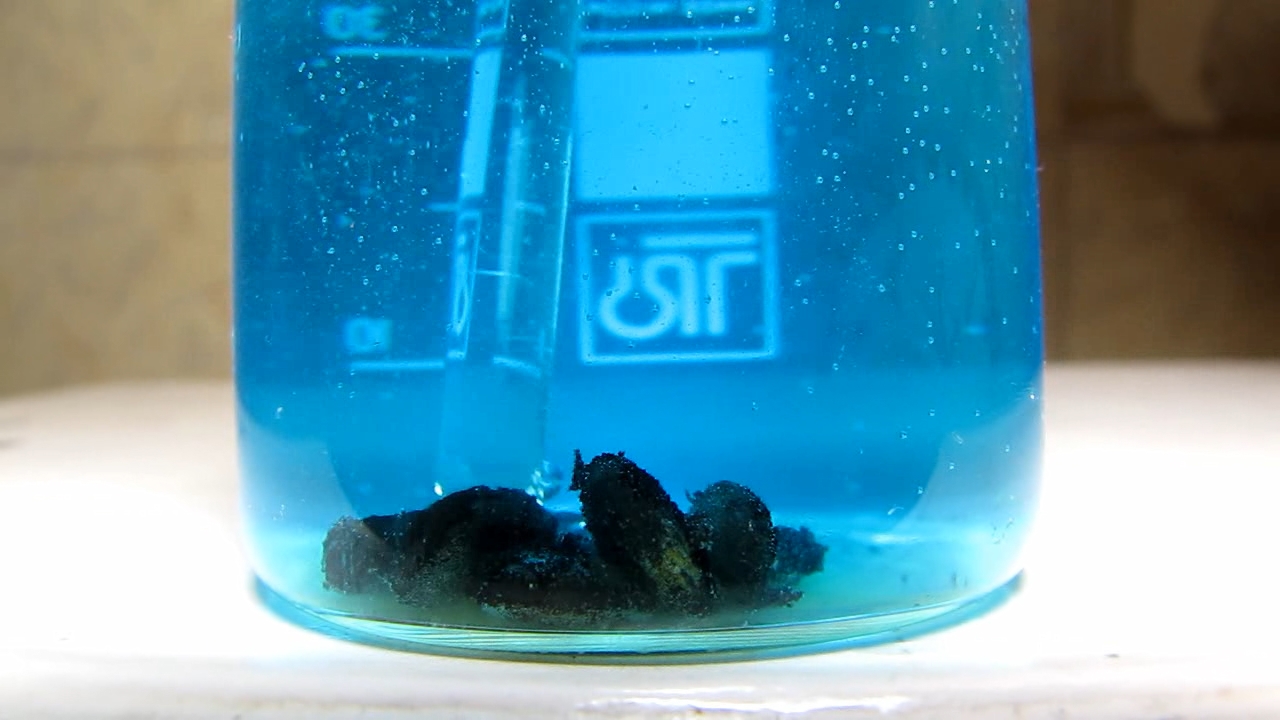
|
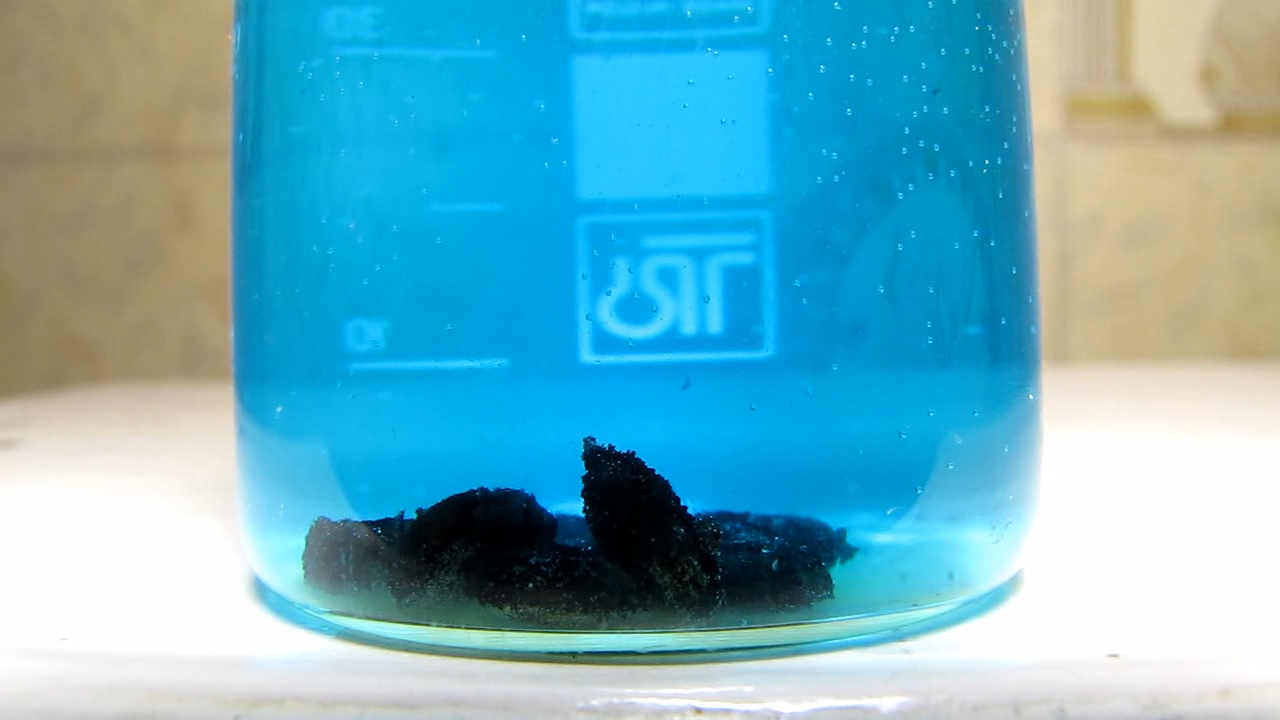
|

|
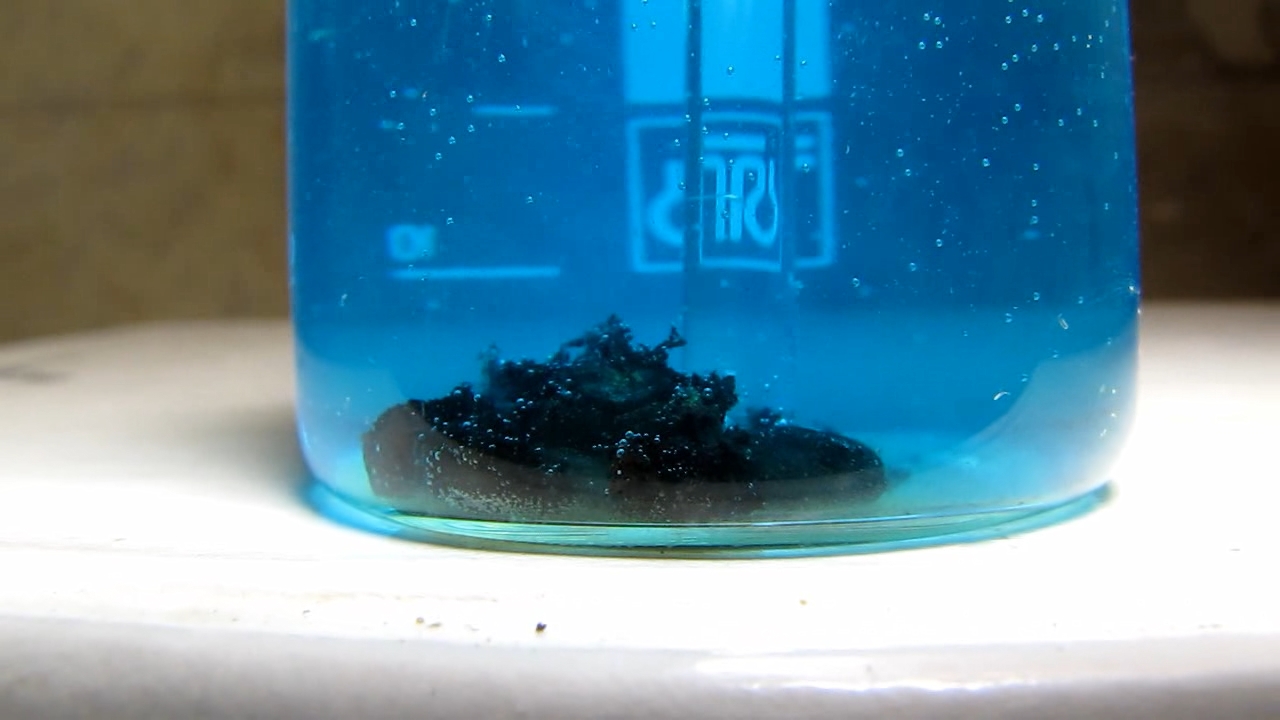
|

|
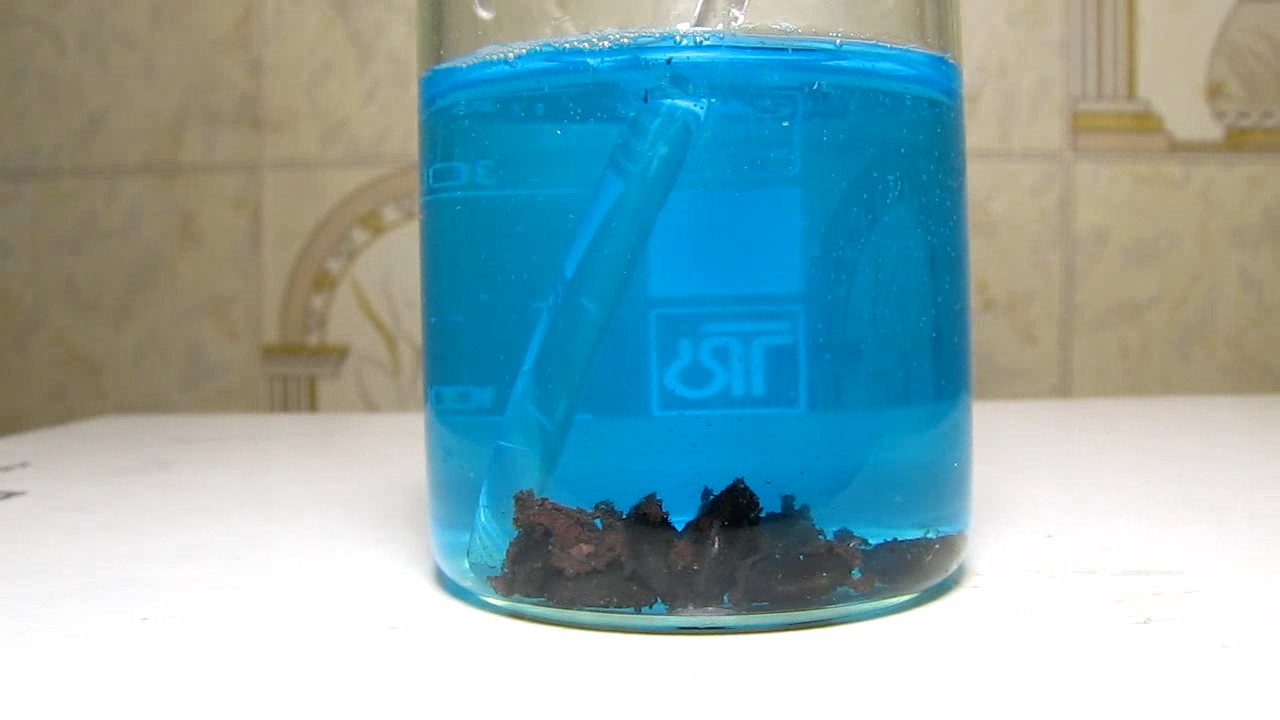
|
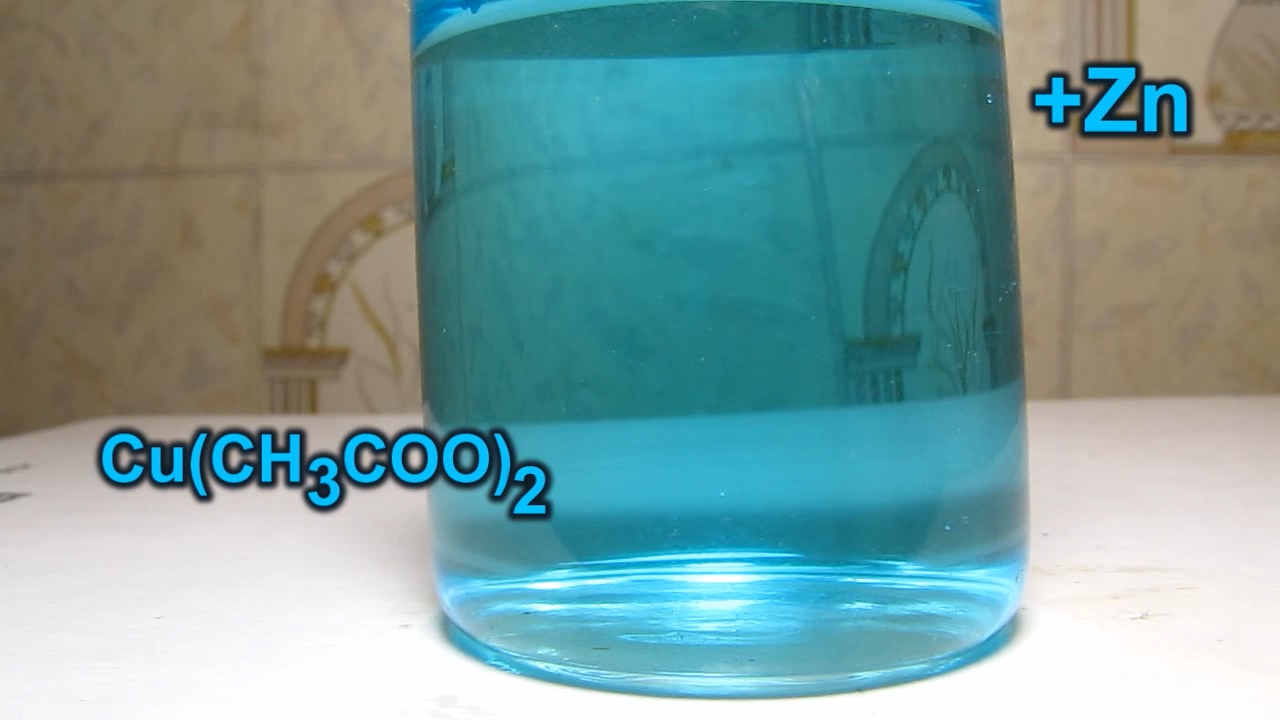
|

|
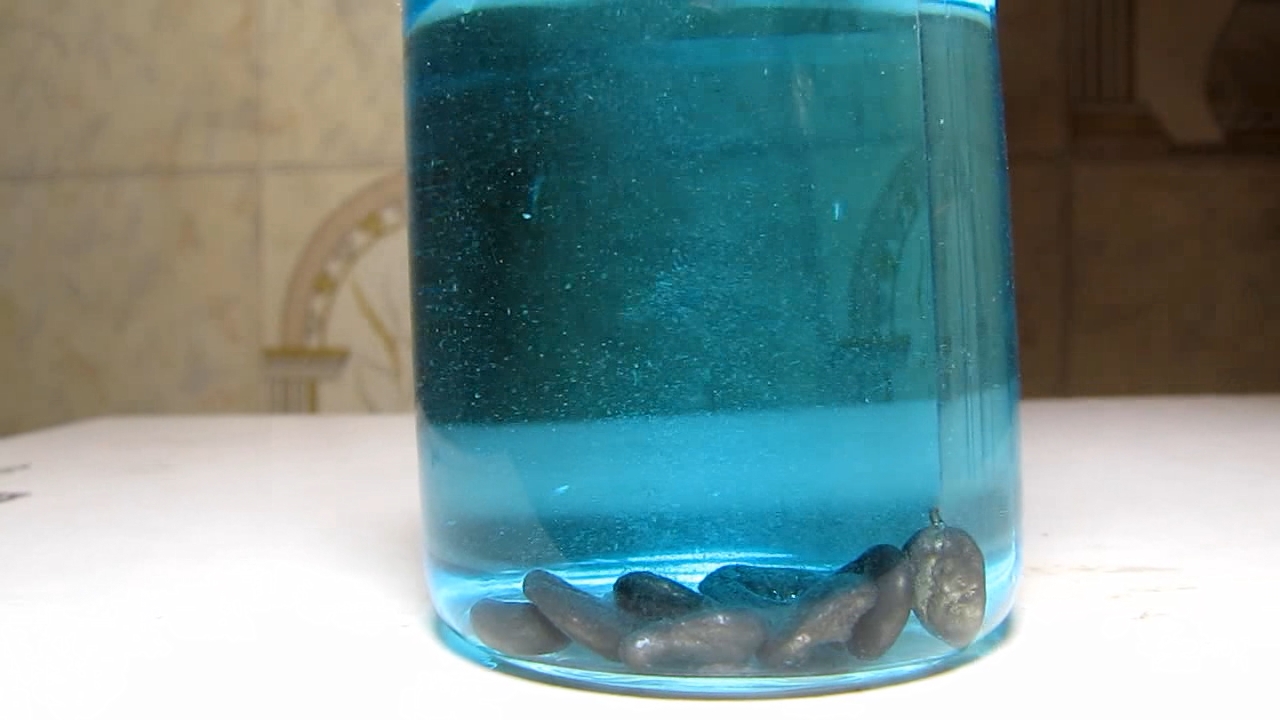
|
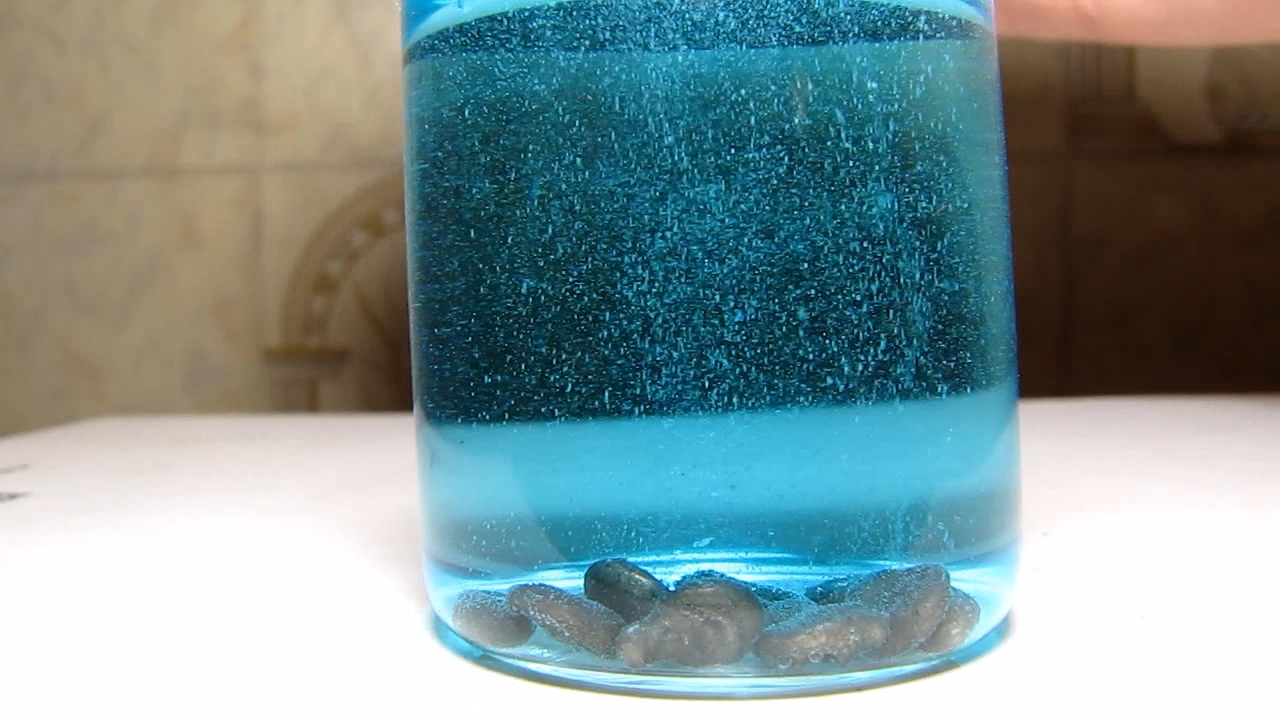
|

|
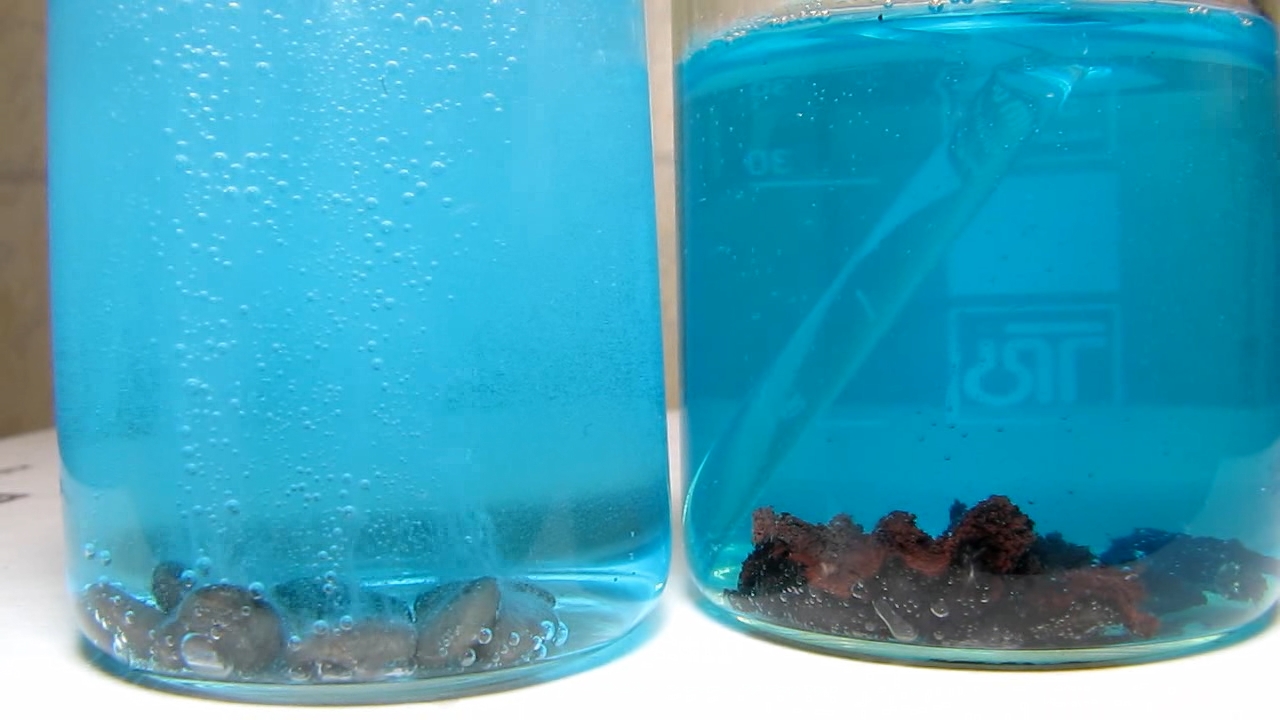
|
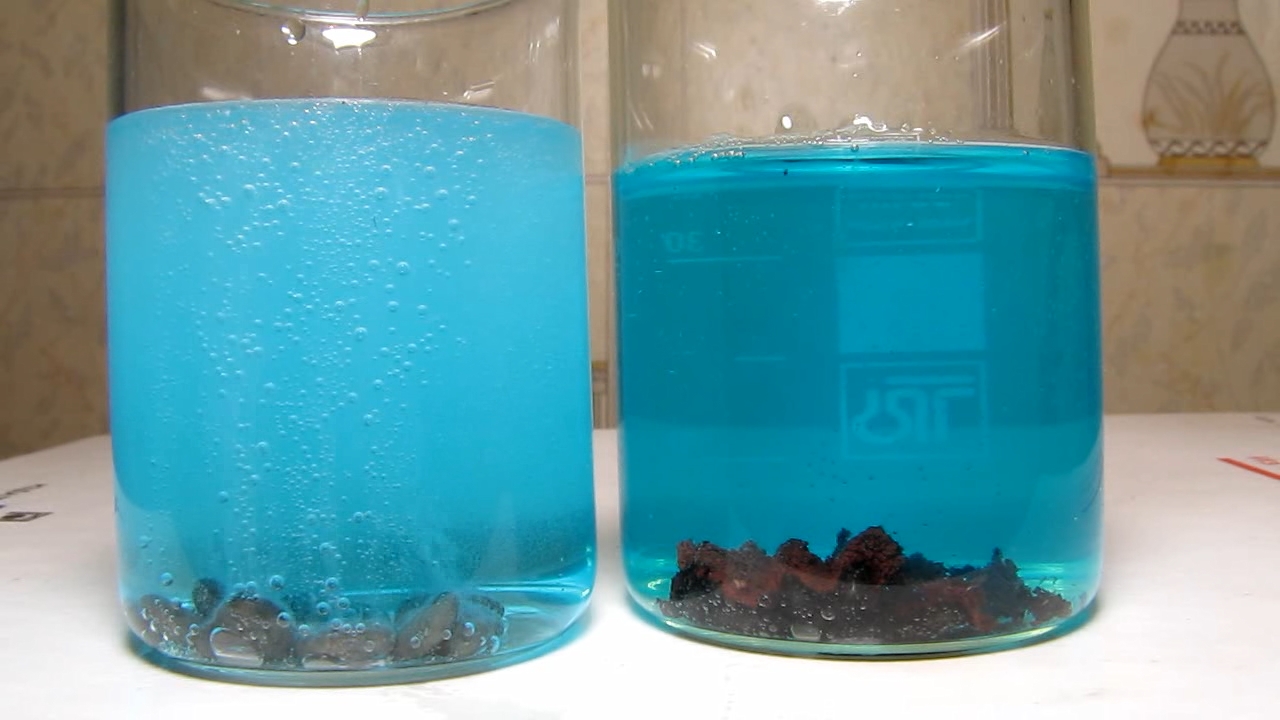
|
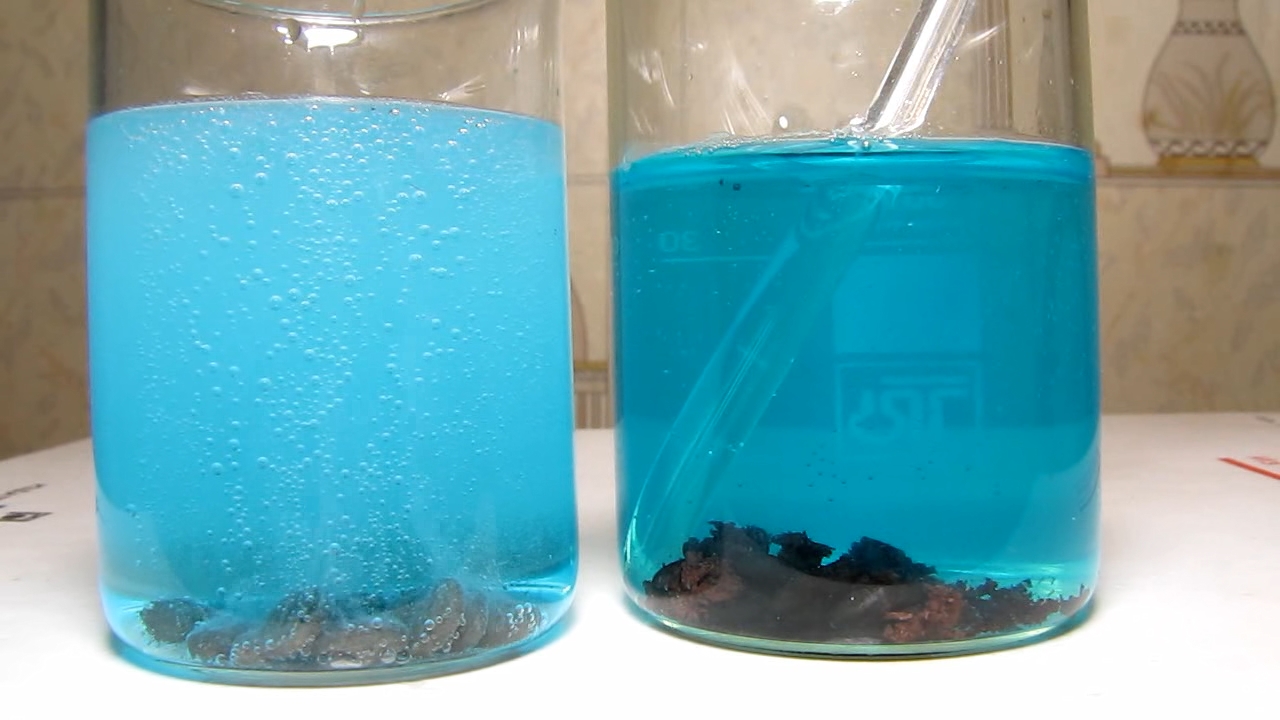
|
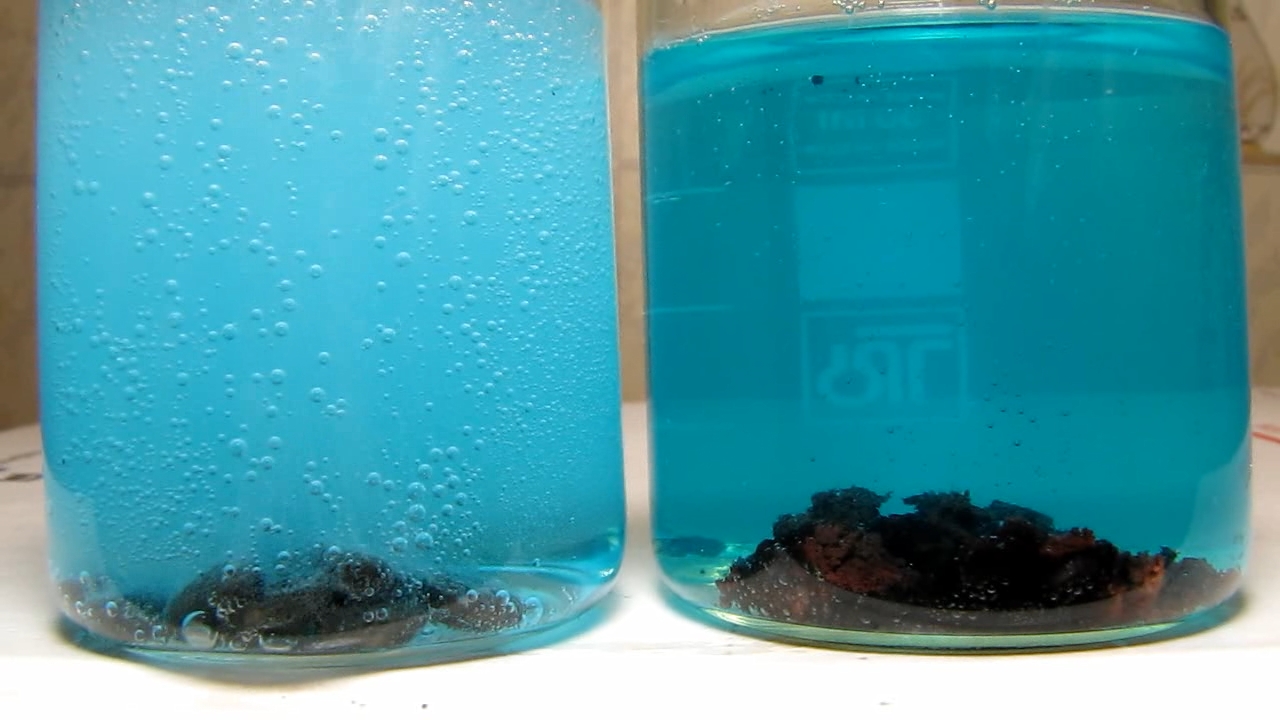
|
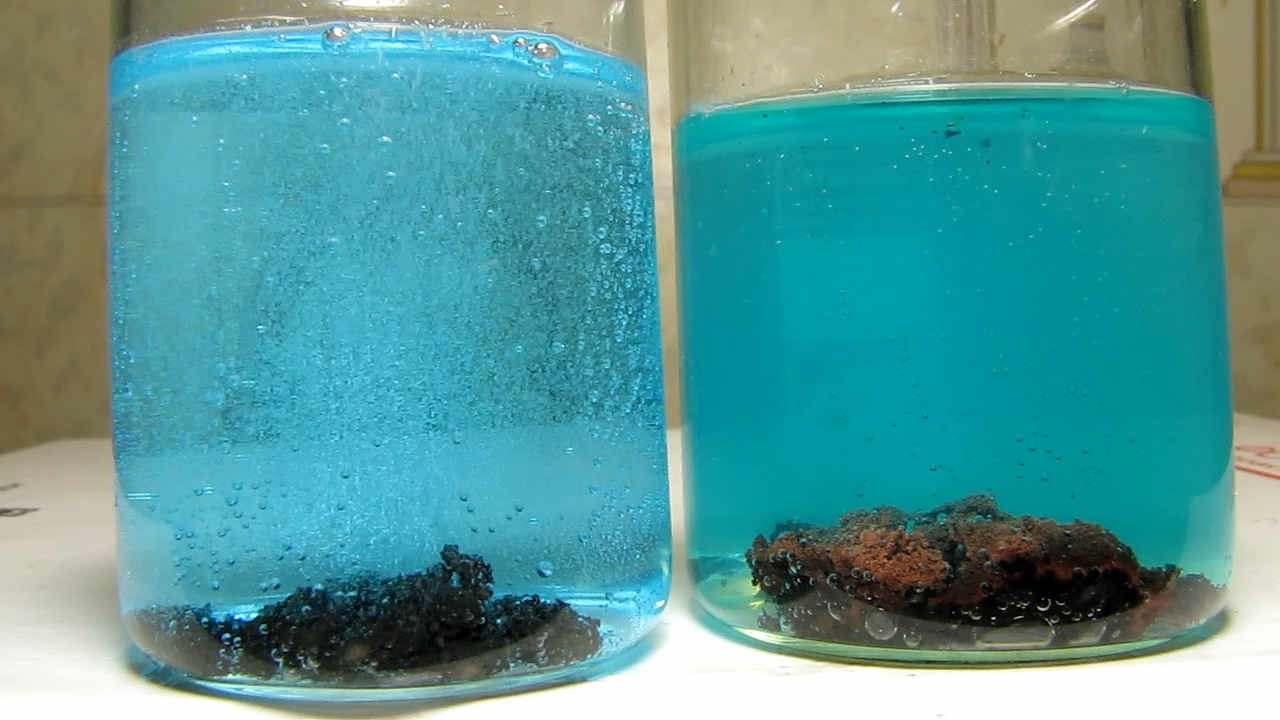
|
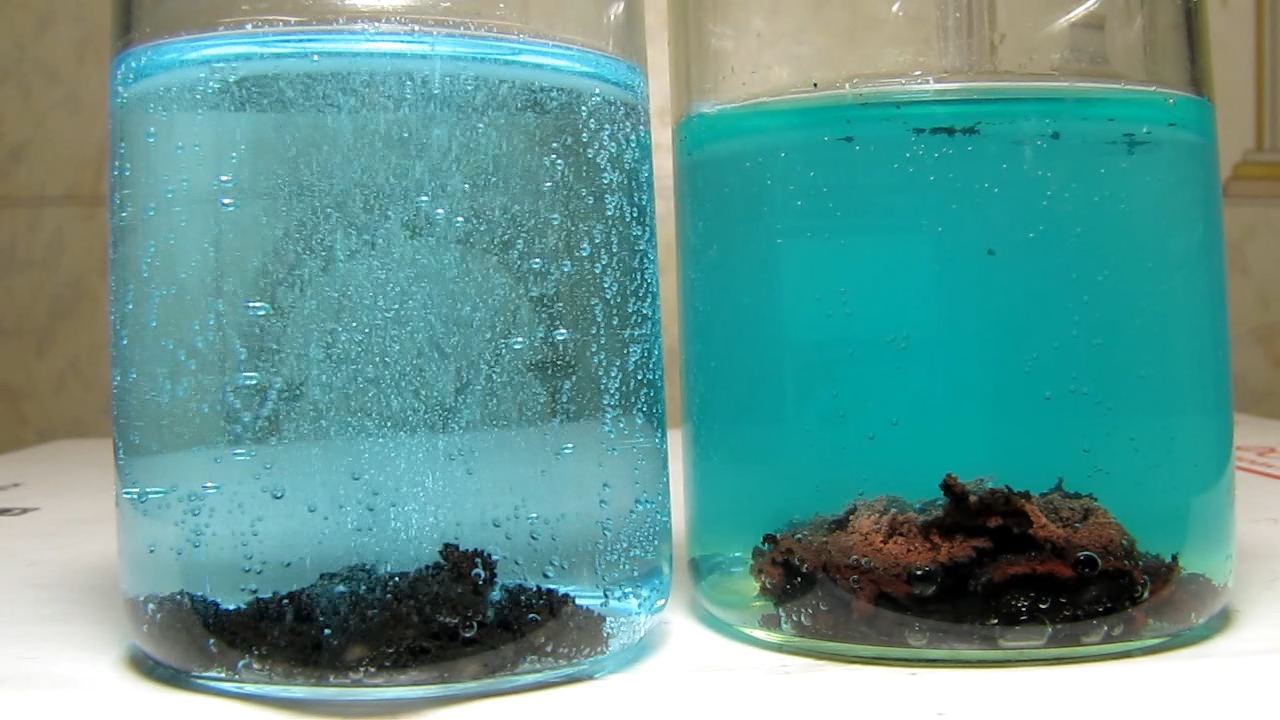
|
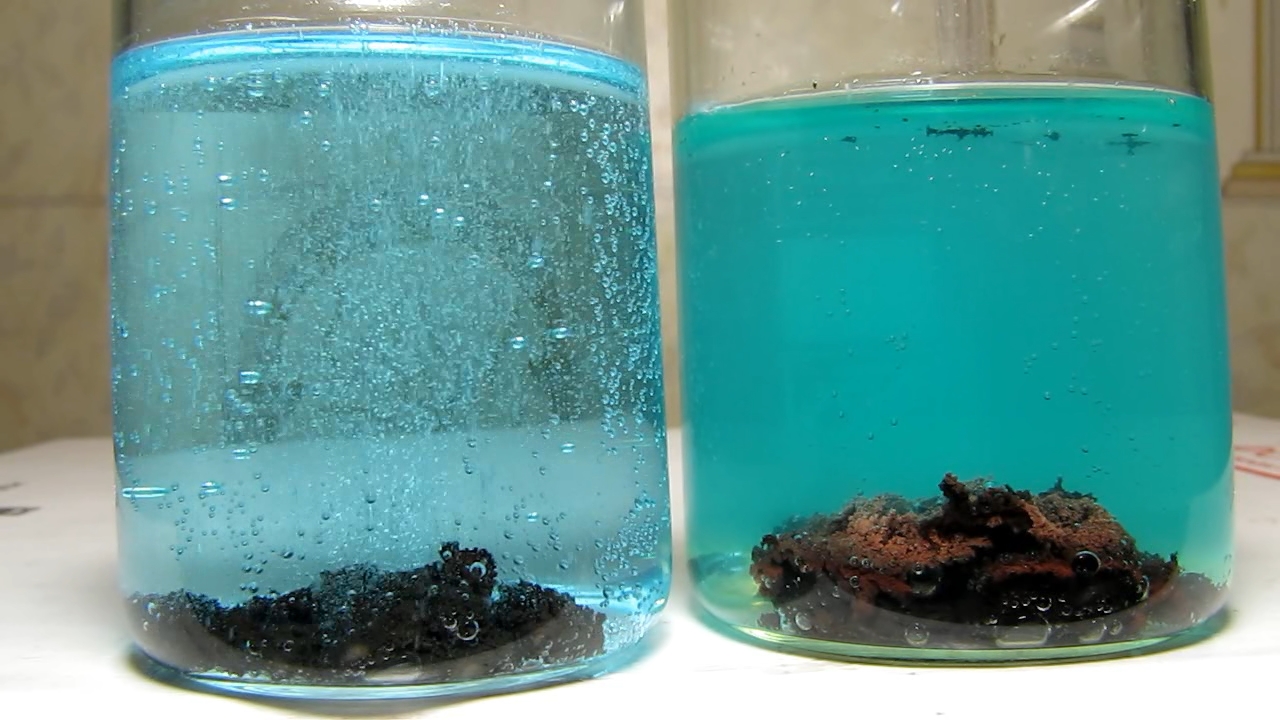
|
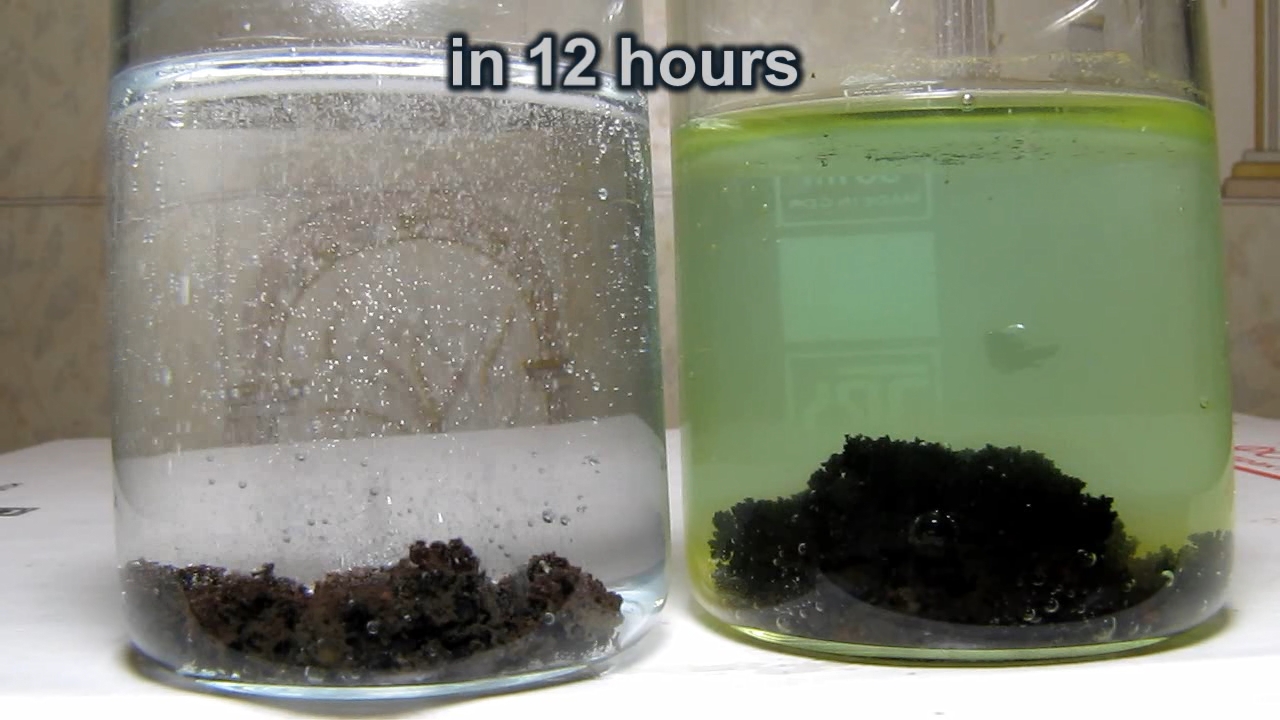
|
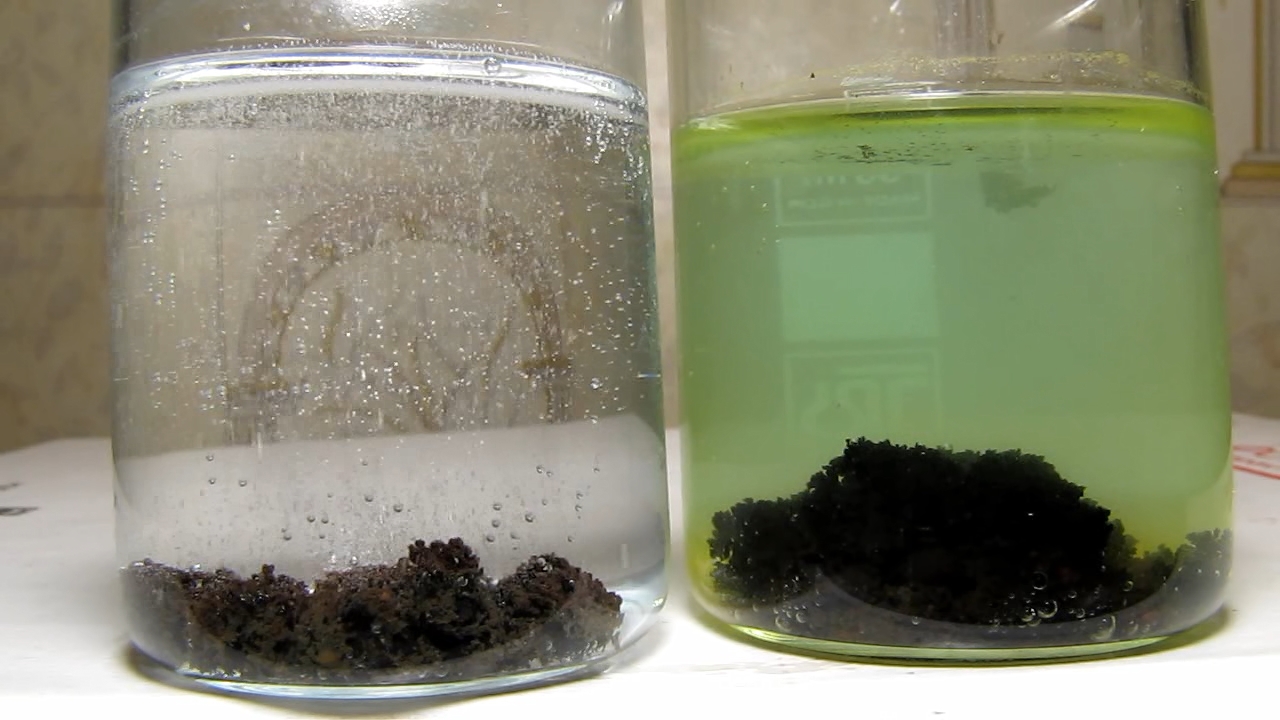
|

|

|
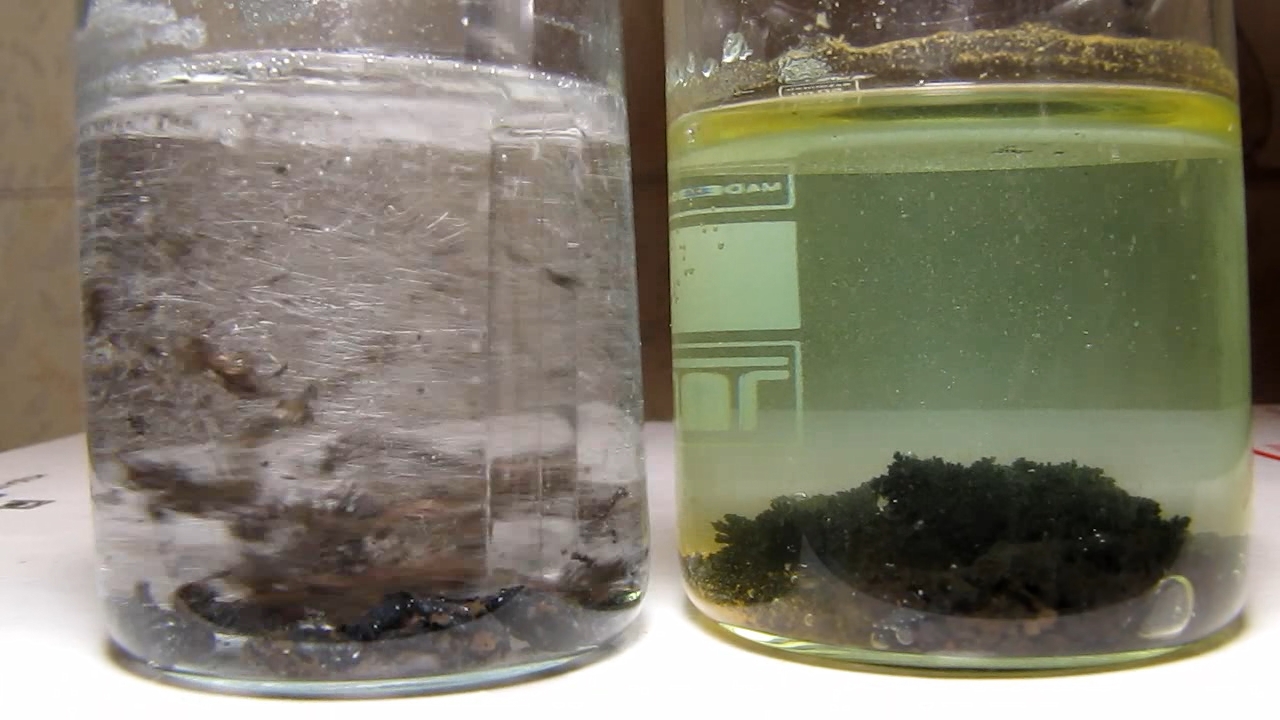
|

|
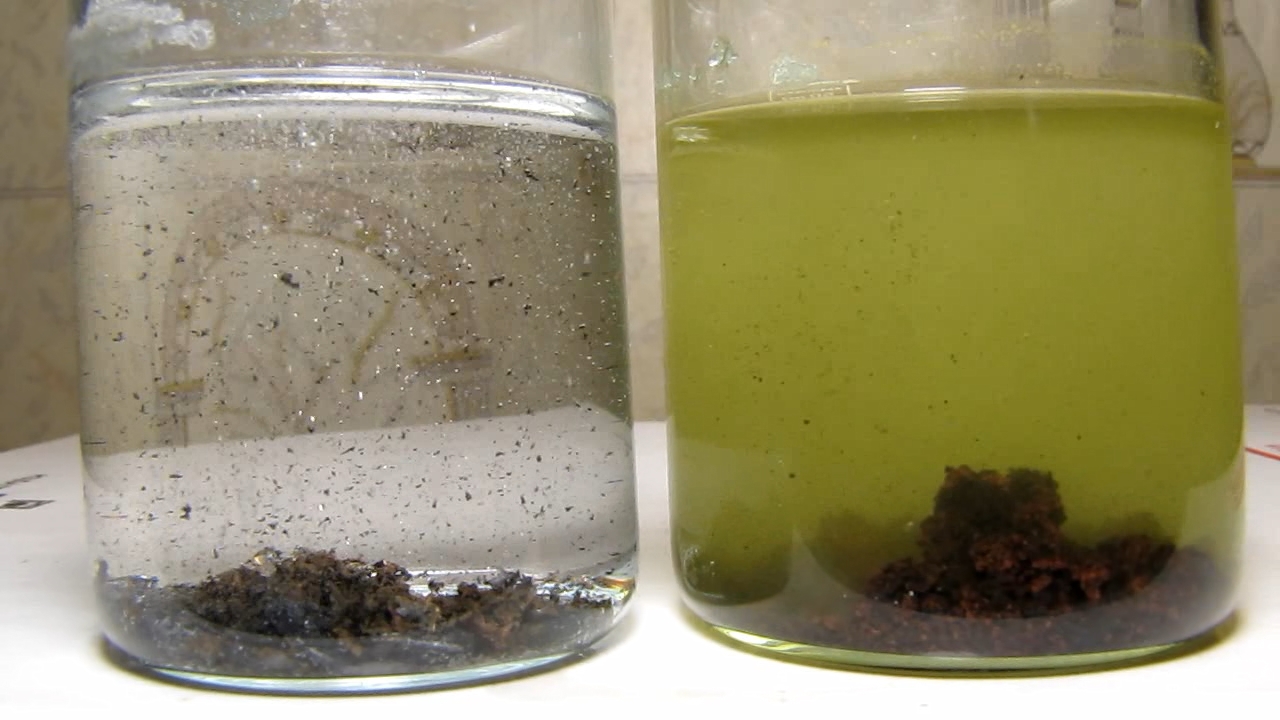
|
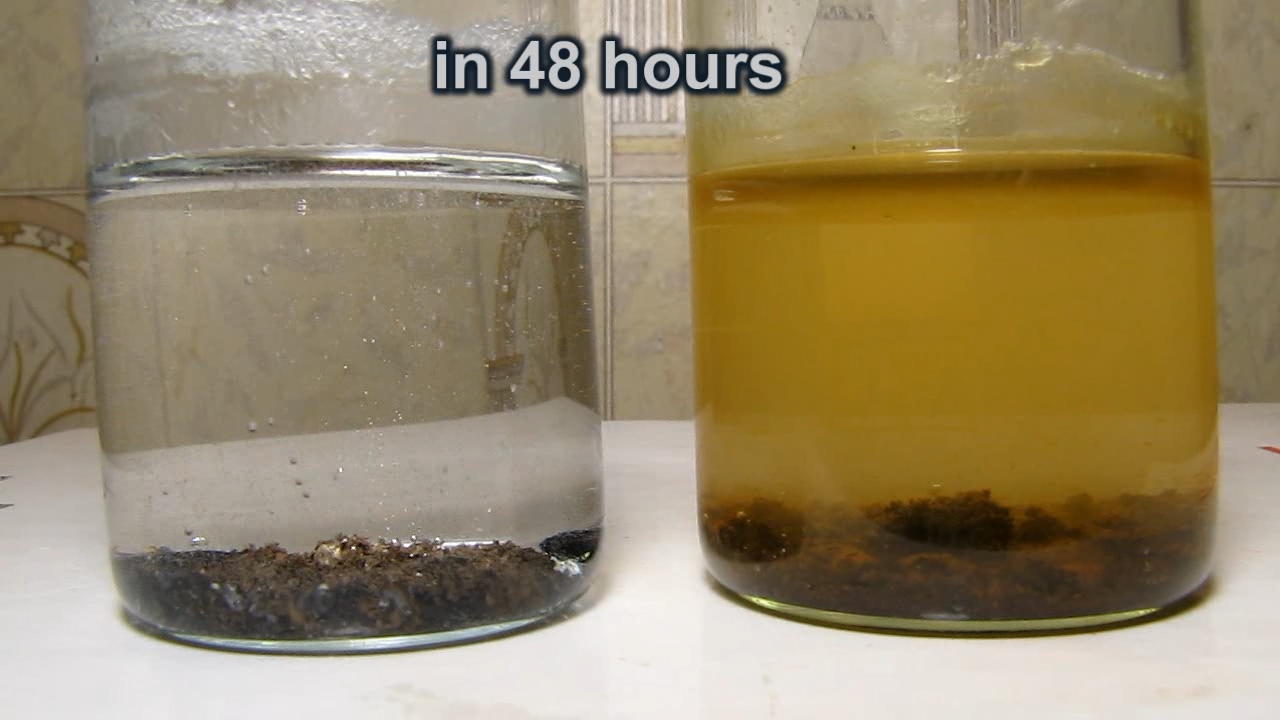
|

|

|
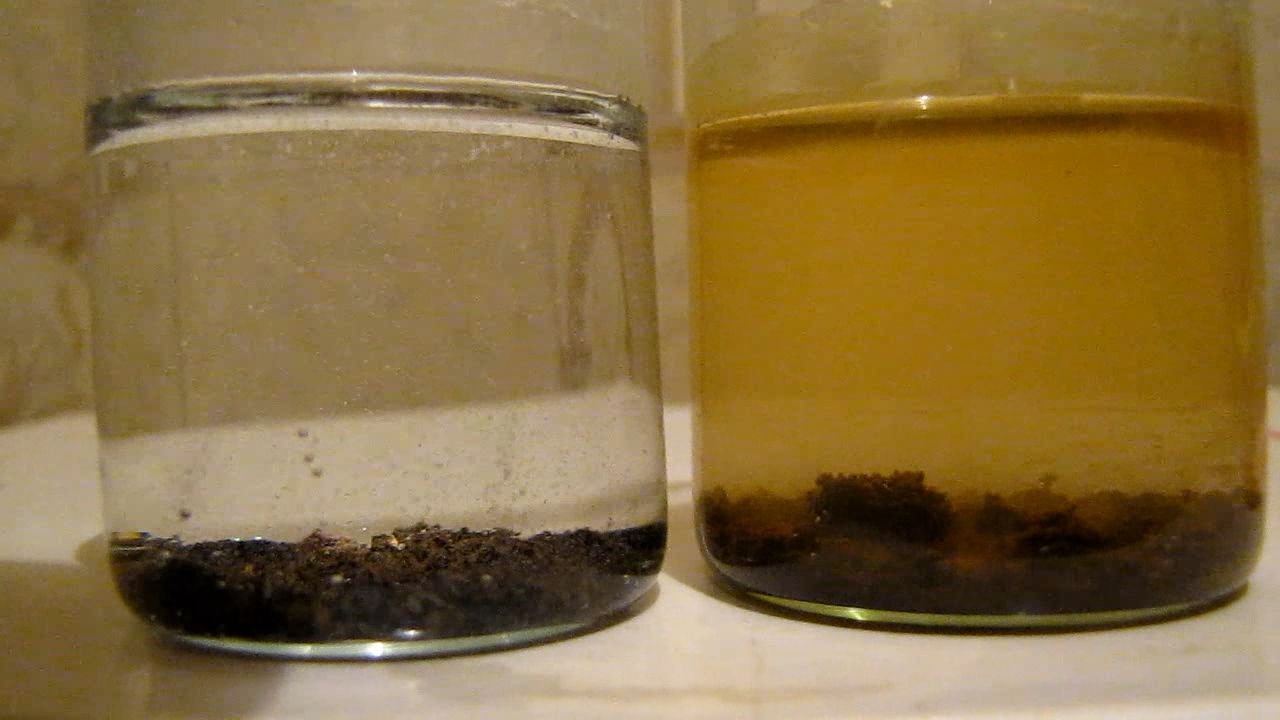
|
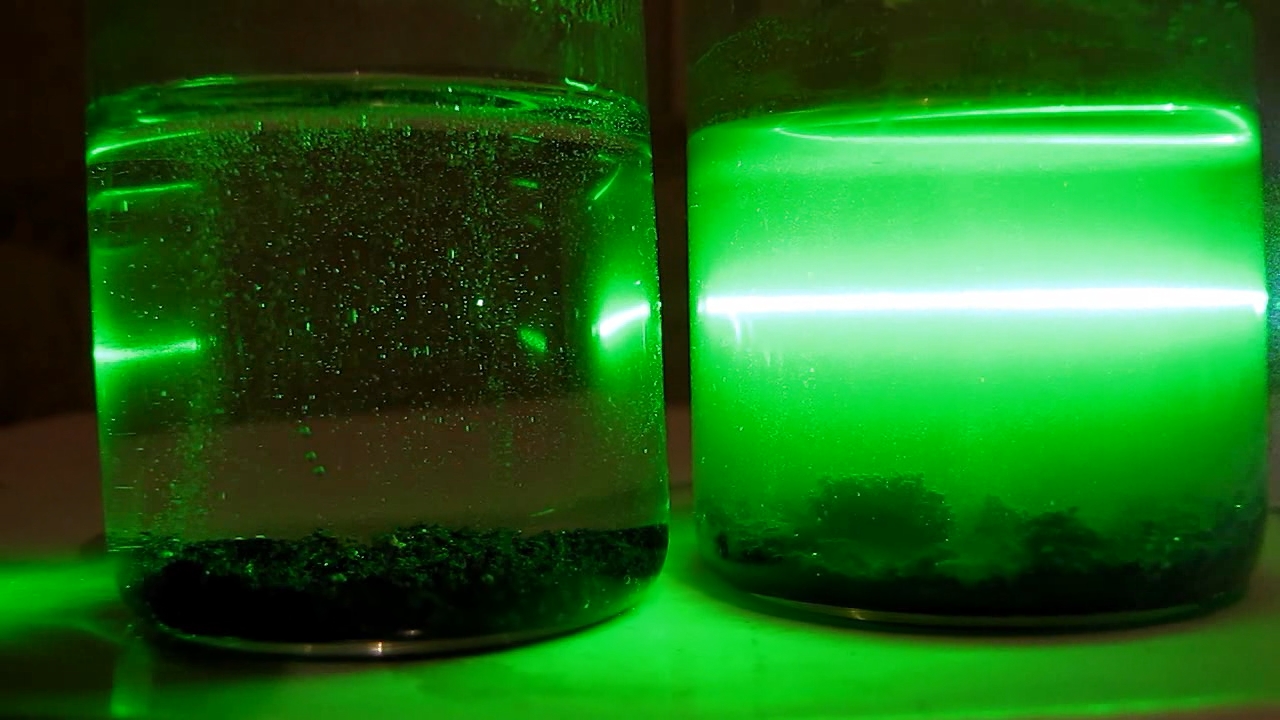
|
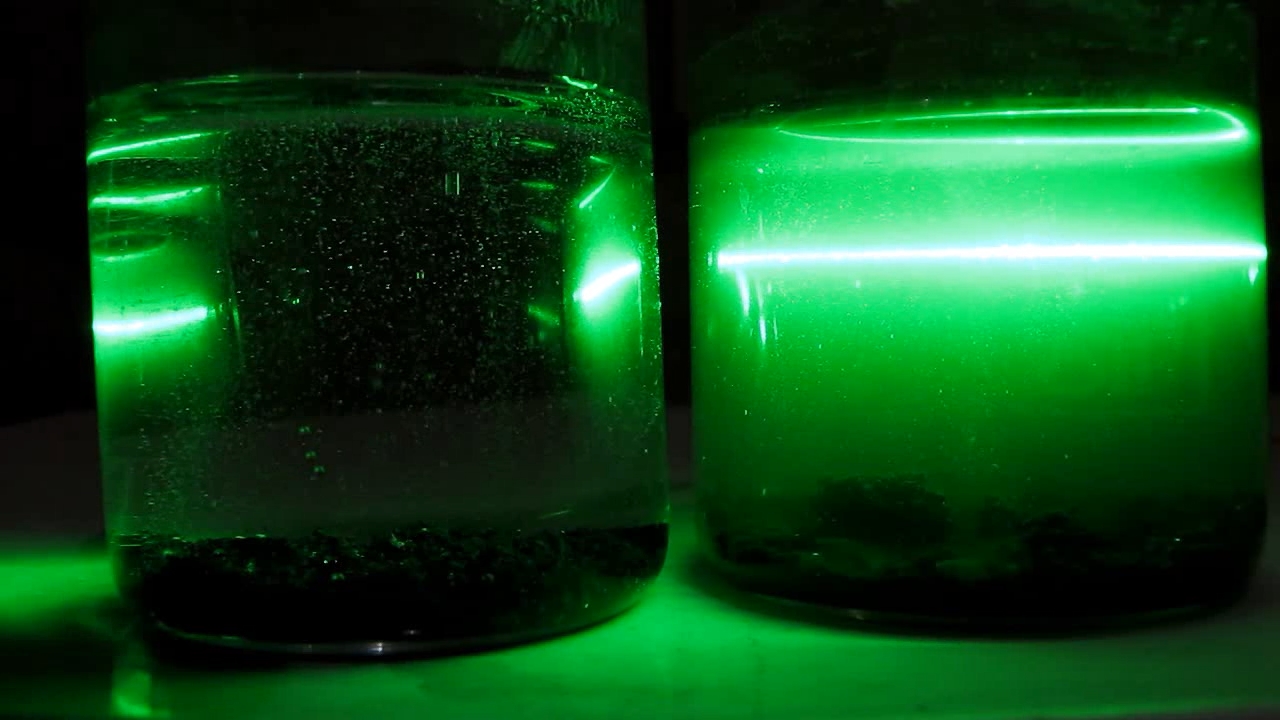
|

|

|
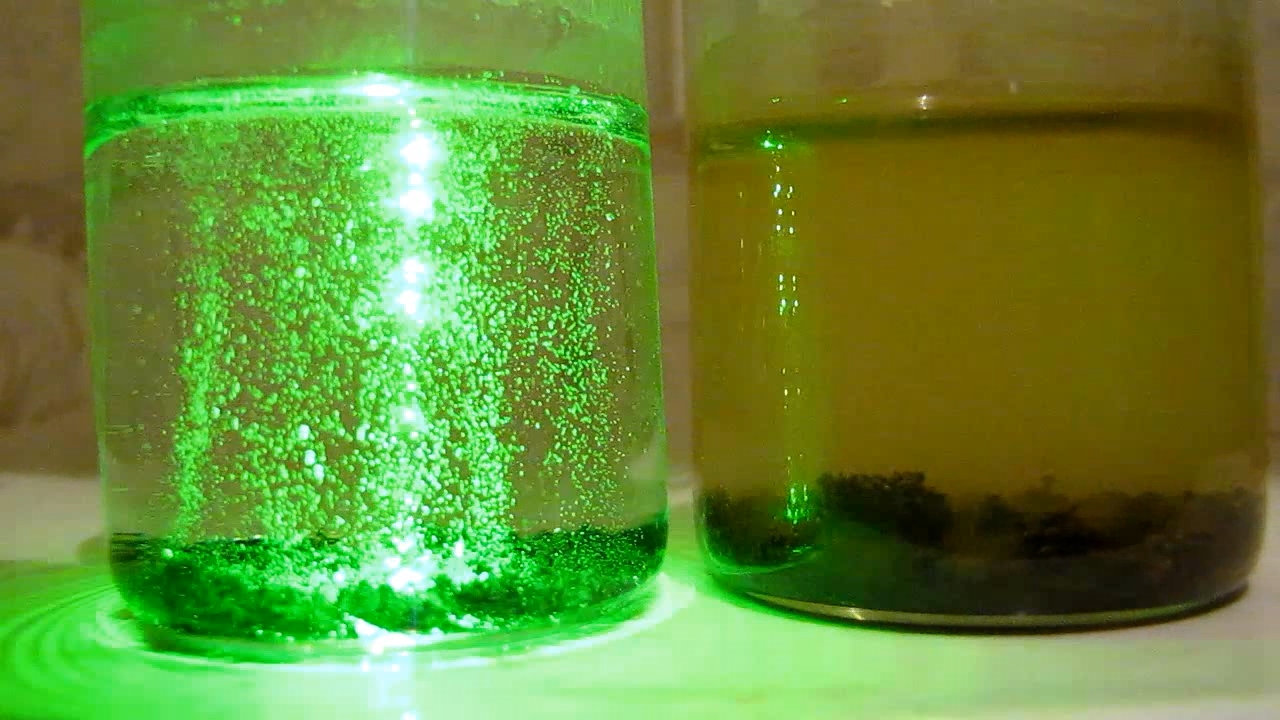
|

|
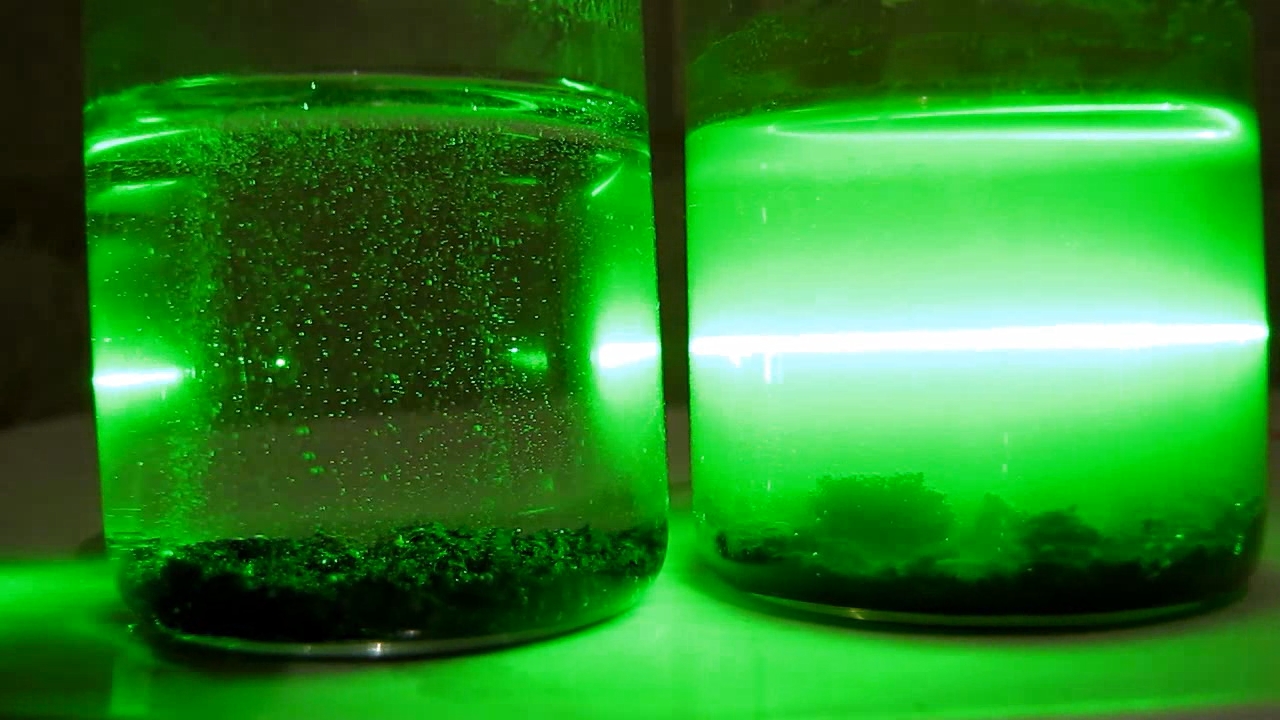
|
|
Ацетат меди, сульфат меди и металлический цинк - ч.4
В предыдущей части статьи описаны реакции железа с растворами сульфата и ацетата меди. С химической точки зрения эксперимент получился, но с эстетической точки зрения я остался неудовлетворен. Поэтому решил поставить новый эксперимент с этими же растворами, несмотря на то что кроме меди в них теперь содержалось двухвалентное железо: Cu2+ + Fe = Fe2+ + Cu Другим доступным металлом, который легко вытесняет медь из ее солей, был цинк. В стакан с раствором сульфата меди я добавил несколько гранул цинка. Поверхность металла сразу стала покрываться черным налетом меди. При просмотре видео эксперимента я заметил, что налет местами был черный, местами - красный (аналогично предыдущему эксперименту). Медь выделялась в виде объемной губки, которая легко отделялась от поверхности цинка при перемешивании. Cu2+ + Zn = Zn2+ + Cu Во время перемешивания стало заметно, что образовались пузырьки газа. Видимо, имела место параллельная реакция: цинк медленно реагировал с ионами водорода, образуя газообразный водород. Раствор сульфата меди имеет кислую реакцию (pH<7) за счет частичного гидролиза. Металлическая медь образует с цинком гальваническую пару, которая ускоряет реакцию цинка с ионами водорода. 2H+ + Zn = Zn2+ + H2 Кстати, сплав Деварда (Devarda's alloy), который состоит из цинка, алюминия и меди, реагирует с водой при комнатной температуре, выделяя водород. Во время этой реакции легко наблюдать образование пузырьков водорода визуально. В случае гранул цинка и раствора сульфата меди образование пузырьков я заметил только при перемешивании. Пузырьки накапливались в порах губчатой меди и высвобождались при механическом воздействии. Примечательно, что выделение металлической меди на поверхности цинка происходило гораздо быстрее, чем на поверхности железа. Когда целью является осаждение меди из промышленных растворов для ее регенерации, железо предпочтительнее цинка (поскольку цинк стоит дороже железа, и он более токсичен для окружающей среды). Однако цинк лучше подходит для реакций замещения во время химических демонстраций перед аудиторией, например, для экспериментов по вытеснению металлической меди из растворов ее солей. Потом я взял раствор ацетата меди и добавил в него несколько гранул цинка. На поверхности цинка стала образовываться медная губка, местами она была черной, местами красной. Скорость образования металлической меди была заметно ниже, чем в случае реакции сульфата меди с цинком. Зато в стакане с ацетатом меди наблюдалось активное выделение пузырьков водорода. Как было отмечено выше, раствор ацетата меди содержал избыток уксусной кислоты. Уксусная кислота реагировала с цинком, а металлическая медь ускоряла этот процесс. Со временем скорость выделения водорода не ослабевала, а интенсивность окраски раствора уменьшалась. Окрашенные катионы меди осаждались из раствора в виде металлической меди, а их место занимали бесцветные катионы цинка. Тем временем в другом стакане раствор сульфата меди стал мутным и начал приобретать зеленый оттенок. На дне стакана была красная и черная медная губка. Оставил растворы на ночь. До утра в стакане с ацетатом меди раствор обесцветился (вся медь была в осадке в виде металлической меди), выделение водорода продолжалось. В стакане с сульфатом меди раствор был зеленовато-желтым, мутным. На дне был осадок металлической меди и бурый осадок, похожий на гидроксид железа (III), Fe(OH)3. Через 48 часов в стакане, где изначально был раствор ацетата меди, выделение газа все еще продолжалось (!). Раствор был прозрачным и бесцветным. На дне - серая губка металлической меди. В стакане, где в начале опыта был сульфат меди, раствор стал коричневым и мутным. Его внешний вид напоминал суспензию гидроксида железа (III) (ржавчины). На дне был коричневый осадок. Образование гидроксида железа (III) объяснить просто. При реакции сульфата меди с металлическим железом образовался сульфат железа (II), который остался в растворе. В стакане с сульфатом меди не было избытка кислоты. Более того, часть ионов водорода, которая образовалась при гидролизе сульфата меди, прореагировала с цинком. В нейтральном, а тем более щелочном растворе соли железа (II) окисляются кислородом воздуха с образованием гидроксида железа (III) (и/или основных солей трехвалентного железа): 4Fe2+ + O2 + 10H2O = 4Fe(OH)3 + 8H+ В стакане с ацетатом меди имел место избыток уксусной кислоты (в результате чего раствор был кислый, pH < 7). Также происходило активное выделение водорода - водород частично изолировал раствор от кислорода воздуха. Более того, в данных условиях железо (II), которое находилось в растворе, вполне могло восстановиться до металлического железа. Последнее утверждение не является голой теорией. Например, автор не раз наблюдал, что металлический магний восстанавливает раствор сульфата железа (II) или хлорида железа (III) до металлического железа [1]. Итак, мы имеем два стакана с жидкостью и осадком. В одном жидкость прозрачная и бесцветная, во втором над осадком находится суспензия гидроксида железа (III). Я взял зеленую лазерную указку, чтобы продемонстрировать эффект Тиндаля. В стакане с суспензией луч лазера был хорошо виден - он образовал яркую зеленую линию с боковым свечением, за счет того, что частицы гидроксида железа рассеивали свет. В стакане с бесцветным раствором тоже наблюдалось рассеяние света за счет пузырьков водорода, но оно было намного слабее. |